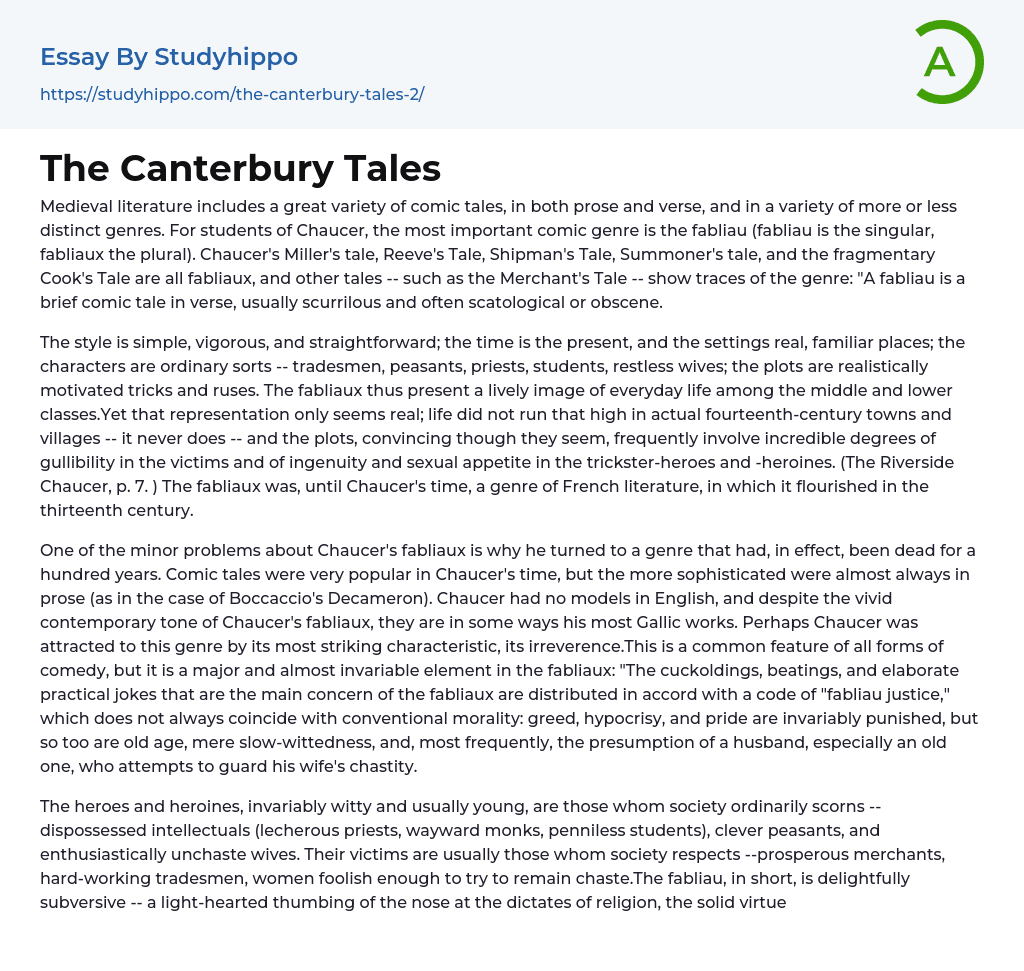Medieval literature features a wide range of humorous stories, both in prose and verse, across various genres. Among these genres, the fabliau (plural: fabliaux) is of particular importance to Chaucer students. The Miller's Tale, Reeve's Tale, Shipman's Tale, Summoner's Tale, and the fragmentary Cook's Tale all belong to the fabliau genre while other tales like the Merchant's Tale exhibit its characteristics. Simply put, a fabliau is a brief comic tale in verse known for its scurrility and often obscene or scatological content.
Until Chaucer's time, the fabliaux was a genre of French literature that flourished in the thirteenth century. This literary style features familiar real-life locations and everyday characters like peasants, tradesmen, students, priests, and restless wives. The plots often involve clever tricks and ruses that are realistically motivated, presenting a vivid picture of daily life among the
...middle and lower classes. However, the representation is not entirely accurate as life in actual fourteenth-century towns and villages seldom matched the heightened levels depicted in fabliaux. Additionally, the stories often portray victims as highly gullible while the trickster-heroes and heroines display exceptional ingenuity and sexual appetite. (The Riverside Chaucer, p. 7.)
Chaucer's fabliaux were a genre that had been dormant for over a century, despite the popularity of comic tales in his era, which were primarily in prose (as seen in Boccaccio's Decameron). Chaucer didn't have any English models for his fabliaux, which had a distinctively French flavor and were characterized by irreverence. The fabliaux's most notable feature was the way it distributed its themes of cuckoldings, beatings, and practical jokes in accordance with a "fabliau justice" code that didn't always align with conventional morality. While
greed, hypocrisy, and pride were punished, so too were things like old age and the foolishness of husbands who tried to protect their wives' chastity.In essence, the fabliau is a cheerfully rebellious genre that mocks the norms of religion, citizenship, and courtly literature, making light of the socially disdained but cunning protagonists like lewd clergymen, vagrant monks, and impoverished scholars, canny peasants, and enthusiastically promiscuous wives. The targets of their schemes are generally the well-to-do merchant class, industrious craftsmen, and imprudent women who remain chaste. These tales frequently parody high-class literary ideals and behaviors, as well as the working-class efforts to emulate them. (The Riverside Chaucer, p.)
8.) The writers of the fabliaux exhibit an aristocratic perspective in their work, with a particular harshness towards social climbers, as seen in Guerin's Berenger of the Long Arse. This is not unexpected, given that some fabliau authors were courtly writers, including Jean Bodel who wrote several romances and the fabliau Gombert and the Two Clerks, as well as Marie de France, whose fables feature two fabliaux depicting women's deceit. It is likely that Marie's audience for her refined lays of courtly love also enjoyed her fabliaux, as both genres often displayed a disregard for conventional morality.
To justify this morality, one can refer to works such as The Wright's Chaste Wife from the late fifteenth century that do not belong to the courtly genre and even oppose it. This work examines the fabliau world from the perspective of the laboring classes.
- Book Summary essays
- Metaphor essays
- Reader essays
- Rhyme essays
- Literary devices essays
- Villain essays
- Books essays
- Genre essays
- Literary Criticism essays
- Writer essays
- Protagonist essays
- Simile essays
- Poem essays
- Book Report essays
- Book Review essays
- Greek Mythology essays
- Plot essays
- Tragic Hero essays
- Coming of Age essays
- Play essays
- Rhetoric essays
- Rhetorical Question essays
- Translation essays
- Understanding essays
- Reason essays
- Character essays
- Letter essays
- American Literature essays
- Literature Review essays
- Utopia essays
- Poetry Analysis essays
- Dante's Inferno essays
- Between The World and Me essays
- Incidents in The Life of a Slave Girl essays
- Flowers for Algernon essays
- Myth essays
- Everyday Use essays
- Boo Radley essays
- Genesis essays
- Richard iii essays
- Alice in Wonderland essays
- On the road essays
- Ozymandias essays
- The Nightingale essays
- Holden Caulfield essays
- Animal Farm essays
- 1984 essays
- A Hanging essays
- Shooting An Elephant essays
- A Tale Of Two Cities essays




